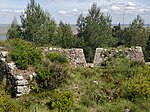Vila Franca de Xira (Portuguese pronunciation: [ˈvilɐ ˈfɾɐ̃kɐ ðɨ ˈʃiɾɐ] ) is a city and municipality in the Lisbon District in Portugal. The population in 2021 was 137,659, in an area of 318.19 km2.Situated on both banks of the Tagus River, 32 km north-east of the Portuguese capital Lisbon, settlement in the area dates back to neolithic times, as evidenced by findings in the Cave of Pedra Furada. Vila Franca de Xira is said to have been founded by French followers of Portugal's first king, Afonso Henriques, around 1200.
The town is mostly famous for its bull-running festivals in July and October. Bulls are raised in the salty marshlands of the Ribatejo, which is also a notable breeding ground for the Lusitano horse, esteemed for its quick reflexes and maneuverability. A number of brightly coloured Portuguese bullfighting costumes are on display in the ethnographic museum in the town's bullring, the Praça de Toiros (or Touros) Palha Blanco.
Notably, the town was the stage for the eponymous Vilafrancada in May of 1823. The Vilafrancada was an insurrection led by prince Miguel I of Portugal, son of King John VI of Portugal, which sought to reestablish an absolutist monarchy in Portugal. This came in response to the Portuguese Constitution of 1822 - the Kingdom's first constitution - which turned Portugal from an absolutist monarchy to a parlamentarian monarchy. The Vilafrancada can be seen as a prelude to the Portuguese Civil War of 1828-34.
In 1951, the town benefited from the completion of the Marechal Carmona Bridge. Located almost equidistantly between Lisbon and Santarém, The town provided an ideal place for a road bridge. The bridge was the first to cross the Tagus in the Lisbon region, and remained its only crossing until the inauguration of the 25 de Abril Bridge fifteen years later. As a result, Vilafranca experienced greater traffic and commercial opportunities during this period.
Nearby, the town's Misericórdia church features striking 18th-century azulejos (glazed tiles). The town also has a Museum of Neo-Realism.Three km south of Vila Franca de Xira lies the Lezíria Grande Equestrian Centre, where visitors can watch stylish displays of the impressive Lusitano horses. The centre also stages typical bullfighting spectacles in its outdoor bullring. Visitors can ride Lusitano horses and take dressage lessons at the Quinta de São Sebastião, a sprawling estate at Arruda dos Vinhos, 11 km west of Vila Franca de Xira.
The municipality contains several forts built during the Peninsular War and forming part of the Lines of Torres Vedras. These include the Fort of Subserra on the first line of defence and the Forts of Serra da Aguieira and the Fort of Casa on the second line.
Another place of interest, on the left bank, is the Hermitage of Nossa Senhora de Alcamé, which was built so that farmers on the Tagus floodplain would both have somewhere to pray and also somewhere of safety during floods. An annual pilgrimage is held to the hermitage with participants going by boat from the town of Vila Franca de Xira on the right bank.
The current Mayor is Fernando Paulo Ferreira, elected in 2021 as a member of the Socialist Party.








